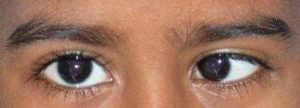AMBLYOPIA
 Amblyopia or Lazy eye is a condition with underdeveloped vision in one or both the eyes during infancy. Children under the age of 8 are at much higher risk of developing Amblyopia, as the vision development almost stops at this age. There are chances of improvement in vision after the age of 8, but the extent to which it could improve depends on the prognosis at an early age.
Amblyopia or Lazy eye is a condition with underdeveloped vision in one or both the eyes during infancy. Children under the age of 8 are at much higher risk of developing Amblyopia, as the vision development almost stops at this age. There are chances of improvement in vision after the age of 8, but the extent to which it could improve depends on the prognosis at an early age.
If not detected early and treated in time, Amblyopia can even result in permanent vision loss. Usually, Amblyopia cannot be detected by just looking at the child’s eyes. It requires a few simple tests which will be performed by an optometrist and an ophthalmologist.
A complete eye examination is warranted which includes vision testing in both the eyes by asking the child to read the letter on a visual acuity chart followed by the refractive power testing to rule out if there is any refractive error such as hypermetropia, myopia and astigmatism which will be tested with and without using eye drops.
The eye alignment will be assessed to see if there are any squint which could be a reason for amblyopia. The amblyopia could be treated with the use of glasses or contact lenses, eye patching, eye exercises, eye drops and in some cases surgical treatment may be required.Duration of the treatment depends on the levels of improvement of vision in the patient which usually continues until equal vision is maintained in both the eyes.
Glasses or Contact Lenses: Glasses play a major role in treating amblyopia as this is the only way to correct the refractive error. In some cases where one eye has the higher refractive error than the other eye, use of contact lenses can be of great value than glasses.
Eye Patching: Eye patches are used to occlude the eye with better vision to stimulate the lazy eye to see more. The eye with better vision is patched with the help of a biocompatible eye patch when the child is wearing glasses. In some children both the eyes are required to be patched alternatively. Duration of patching of eyes varies depending on the severity of the condition.Children who are not co-operative with the patching of eyes can be administered with the eye drops in the eye with better vision to blur its vision temporarily. This way the lazy eye is stimulated or forced to see more.
Eye Exercises: There are some computer-based eye exercises wherein the child is required to play video games and solve puzzles in a supervised manner wearing 3D glasses.
Surgery: Children with amblyopia due to squinting of the eye, cataract, ptosis require surgical intervention.